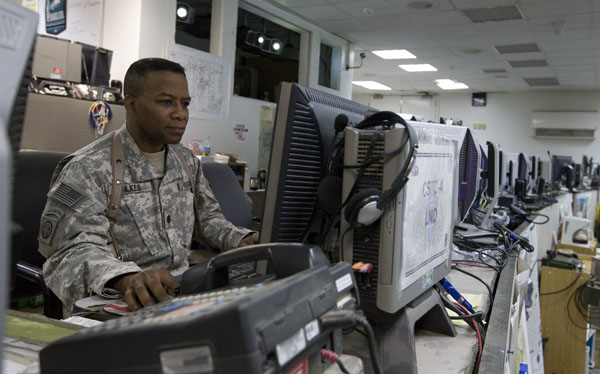known as "Kill TV"
Inside the Bridge: Behind the scenes of a strike into Pakistan

Inside the Bridge, five massive projected screens dominate the main wall, and stadium-style layout allows personnel manning the various workstations to view the screens with an unhindered view. Despite having a business-like workplace feel, the Bridge maintains a throbbing pulse, with personnel constantly monitoring, analyzing, and disseminating the intelligence pouring into their sections. The nature of the work performed in the Bridge plays a fundamental role in the Coalition's ability to target and disrupt insurgent activities and fugitive commanders.
Fluorescent lights keep the room bright 24 hours a day. The sheer amount of computer equipment is a striking feature. The workers dressed in uniform go about their business.
But inside this overhauled Soviet-era hangar on Bagram Air Field, Afghanistan's sprawling main hub for international operations, lies the heart of the effort to hunt Taliban and terrorist masterminds: The Joint Operation Center's operation cell, aka "the Bridge."
The Long War Journal's Phil Peterson had extraordinary access inside the Bridge during the evolution of the March 12 strike that destroyed a Haqqani Network safe house in Pakistan.
The March 12 strike originated from intelligence gathered on the ground from a subordinate unit seeking information on the Haqqani Network. After full-motion video and other "special intelligent collection capabilities" were performed, the Bridge confirmed this particular compound was indeed a safe house for insurgents. Analysts continued to scrutinize the area looking for any signs of life, the presence of women or children, and activity in neighboring structures. Other disciplines, such as law and weapons, are consulted as well. In this case, intelligence assets reported no presence of civilians in the area over the previous five days, making the decision to launch a strike urgent. Full-motion video captured and projected on to the center projection screen -- known as "Kill TV" -- several individuals performing sentry duty in and around the Haqqani Network compound's boundaries.
At 9:40 PM local time, Coalition forces declared an imminent threat from the compound and gathered in the Bridge to discuss the possibility of striking the compound. Due to its location inside Pakistan, the proposal was sent up the chain of command to US Central Command and ISAF (International Security Assistance Force). After discussing the latest intelligence reports, rechecking and confirming their accuracy, the commanding general ordered the strike.
in the minutes leading up to the strike, everyone was working to make sure their data and intelligence was correct. In the final seconds, all eyes were on Kill TV, some people were sitting while others were standing, to see the real time video of the impending strike.
There was no cheering or high fives; only a hushed "ohhh" from a few people when the strike was made.
The strike was completed and work resumed as usual. Personnel returned to their workstations and the designated section began the process of contacting Pakistan officials to let them know about the strike. Analysts continued studying the streaming video images looking for signs of life in and around the area while other teams at offsite locations were doing the same and then feeding their conclusions to the Bridge commander.
SOURCE:
http://www.longwarjournal.org



0 Comments:
Post a Comment
Subscribe to Post Comments [Atom]
<< Home